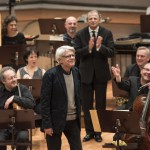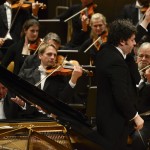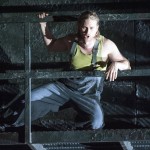By Rebecca Schmid
“If opera wants to find the connection to ‘great theater’ again, it has to adopt a flexible form that represents new theater’s most valuable qualities,” wrote Kurt Weill in 1929, one year after the Threepenny Opera premiered at Theater am Schiffbauerdamm. A recent visit to that very theater for the Berliner Ensemble in Faust I and II, which premiered earlier this season, made me realize the weight of this statement. As seen on July 9, Robert Wilson’s witty, imaginative staging, together with a score by the songwriter Herbert Grönemeyer, made for a more immersive theater experience than I can recall in any Berlin opera house this season.
Goethe’s two-volume play is condensed to just over four hours (text and dramaturgy: Jutta Ferbers), creating a fast-moving but mesmerizing series of tableaus, from the shimmering, pastel-toned angels of the prologue in heaven to the mock-rococo throne room of the emperor in the second play. Grönemeyer, drawing on a palette of organ, synthesizer, guitar and string quartet, follows suit with a collage-like pastiche, integrating everything from French baroque to Middle Eastern influences. Electronica and ambient sounds timed precisely to the actors’ every move create a filmic effect, while pop-like numbers add a touch of revue. Only the repetitive, not particularly lyrical melody of the final “chorus mysticus” praising the eternal female veered too far toward the mundane.
In Wilson’s reading, Mephistopheles and Faust are two sides of the same coin, transcending good and evil. With the conception of the Homonculus in the second part, the devil tells the sleeping Faust to never forget that he, too, loves. When the title character is united with Margaret, his bourgeois aloofness only makes the viewer empathize with the isolated Mephistopheles, ever seeking fun and pleasure, as he transforms into a ghoul. It is Mephistopheles, however, who is running the show, returning in a more human, attractive guise and handing over one of his horns to Faust in the final scene.
The actor Christopher Nell tirelessly anchored the evening as the demonic protagonist, whether singing a flamenco-like number while air-playing a guitar or hanging above the stage and puffing a cigar. Following a technical problem with the computer-controlled set in the ninth scene of the first play, he returned to tell the audience, “I had nothing to do with it,” and the show carried on with an unwaveringly high level of fantasy and comic timing.
The first act yields not one but four Faust characters and three Margarets, who not unlike the devil and his conquest form multiple parts of a single personality. It is the Faust of Fabian Stromberger who proceeds to the second part, however, easily complimenting Nell with his physical grace and earnest characterization.
One could only wish that the Berlin Ensemble’s sharp acting were possible within the often rigid confines of opera. Grönemeyer’s music may not always be the most sophisticated response to Goethe, and Wilson allows himself a dose of humor which might meet with skepticism in the opera house, but I can hardly imagine a more relevant, entertaining take on a 15th century saga.

![Anna_Bolena_76655[1]](http://www.musicalamerica.com/mablogs/wp-content/uploads/2015/04/Anna_Bolena_766551-150x150.jpg)



 By Rebecca Schmid
By Rebecca Schmid